How can you test a watermelon for nitrates at home?
It's hard to imagine summer without watermelons. These juicy and sugar-fleshed berries hit store shelves in August and become an integral part of the menu in many families for several weeks. They contain a lot of fiber, a complex of vitamins and acids that have a beneficial effect on the body, moreover, the pulp is low in calories.
But the choice of this delicacy must be approached wisely. The whole benefits of watermelons can be nullified by careless farmers who feed plants with fertilizers. This leads to the accumulation of the most dangerous substances in the berries - nitrates. To avoid unpleasant consequences, you need to know about the features of these substances and how to test a watermelon for nitrates at home.
The content of the article
Where do nitrates come from in plants?
Nitrates are derivatives of nitric acid (HNO3) reactions. These substances in small doses are present in any living organism, be it plants or animals. When it enters the body, nitric acid interacts with metals, salts, oxides and hydroxides, resulting in the formation of substances that are called nitrates.
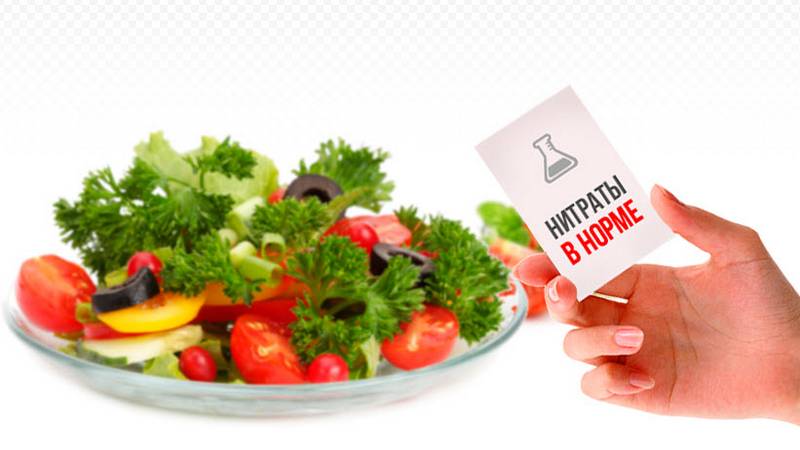 Nitrates play a key role in the life of plants. First of all, they are an indispensable element for the synthesis of protein molecules. As a result of biochemical processes, nitrates are converted into ammonia, which is involved in the formation of chlorophyll - a substance without which photosynthesis is impossible, and therefore plant nutrition. Thus, without nitrates, the plant will simply die.
Nitrates play a key role in the life of plants. First of all, they are an indispensable element for the synthesis of protein molecules. As a result of biochemical processes, nitrates are converted into ammonia, which is involved in the formation of chlorophyll - a substance without which photosynthesis is impossible, and therefore plant nutrition. Thus, without nitrates, the plant will simply die.
Their number depends on various factors: plant varieties, humidity, temperature and lighting levels. But most of all, the amount and type of fertilizer that the farmer uses when growing the fruits affects the level of nitrates.
The permissible norm for the content of nitrates in products is determined by the Federal Law on the Sanitary and Epidemiological Welfare of the Population. In accordance with it, the dose is established - no more than 200 mg / kg.
And here is how the WHO determines the maximum permissible daily dose of nitrates:
- for an adult, the maximum permissible norm of nitrates is 500 mg;
- for a child, the permissible norm is no more than 50 mg.
A person relatively easily tolerates a dose of 150-200 mg of nitrates per day, but a dose of 600 mg is toxic for adults.
Important! It is necessary to carefully monitor the quality of vegetables and fruits when feeding small children. Only 10 mg of nitrates can poison a nursing baby.
Nitrates in watermelons
Due to the popularity of watermelons, farmers try to grow a bountiful harvest as early as possible. Some of them, for the sake of benefit, exceed the safe doses of fertilizers. Thanks to this, they grow huge fruits or get the harvest of striped berries 1-2 months ahead of schedule. But it will be unsafe to eat the result of their labors.
The limiting content of nitrates in watermelons is 40–600 mg / kg of fruit weight.
How to measure the nitrate content of watermelon
An accurate and detailed analysis of the composition of a watermelon is done in the laboratory. Experts use the ionometric method - the concentration of nitrates is determined using potassium alum.
Such verification requires appropriate conditions and the participation of professionals. It is impossible to carry it out at home, even if you know this method. Accurate measurements without errors and errors are only possible in the laboratory.
Home check
But laboratory testing is not the only way to determine nitrate levels. To check what the watermelon is pumped with during the growth process and whether it is safe, it is not necessary to have a laboratory. Even at home, you can check a striped berry for nitrates.
Ecotester
 This device is better known as a nitrate meter - this is how it was nicknamed by the people. It is compact, easy to use and can measure the nitrate content in a watermelon in a few seconds and compare it with the permissible norm.
This device is better known as a nitrate meter - this is how it was nicknamed by the people. It is compact, easy to use and can measure the nitrate content in a watermelon in a few seconds and compare it with the permissible norm.
To measure, select the desired vegetable, fruit or berry from the menu list and insert a special probe into the pulp.
The device makes a measurement and displays the concentration of nitrates. Along with it, the permissible rate is shown.
Important! Do not forget about the measurement error, which is quite large for these devices. For them to be most accurate, you must thoroughly clean the probe before each new measurement.
Indicator strips
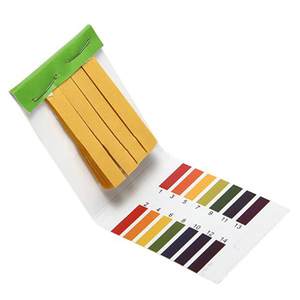
This is an effective alternative to the nitrate meter, acting on the same principle as the litmus tests known to everyone from school. When interacting with nitrates, they change color depending on the concentration of harmful substances.
For verification, you must immerse the strip in watermelon juice or attach to the pulp. Make sure the paper is completely wet and wait 2-3 minutes. After that, the changed color of the indicator is compared with the reference scale, which is attached to the set.
Traditional methods
The methods listed earlier imply the presence of additional instruments and materials for measurement, but they are far from always at hand.
If there are no instruments and materials, folk methods come to the rescue. Although their accuracy is not that high, they are simple and do not require anything other than ordinary water: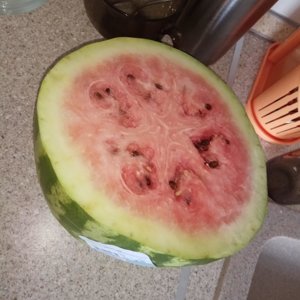
- We place the watermelon in a container filled with water. The nitrate-pumped fruit will sink, and the usable fruit will float on the surface.
- Cut off some pulp (about 20 g), place it in a glass of water and knead it thoroughly. The water should be cloudy and slightly pink. If it has acquired a rich red color, this is a sign of excess nitrates in the pulp.
Signs of nitrate watermelon and selection rules
Many believe that harmful "chemistry" can be detected only with the help of special devices, and it is impossible to distinguish a good watermelon from a bad one by eye. But this is not the case. Even the appearance of the berry can indicate an excess of nitrates. So how do you determine the quality of a watermelon?
The algorithm is as follows:
- The very first sign is size... Too large and early fruits (more than 7-10 kg) clearly grew with an excess of fertilizers, and small ones, most likely, were harvested ahead of time and did not ripen. The optimal weight of a watermelon is 5–7 kg.
- Pay attention to the ponytail... It should be yellow, dry and not too thin. A green and thick tail means that the watermelon is unripe, and it is in these that the concentration of nitrates is often highest.
- Stripes should be contrasting in color.
- Earthen spot should be uniform yellow and of medium size. A pale spot is a sign of immaturity.
- There are no extraneous marks on the rind of a regular watermelon. Brownish black spots are a sign of increased nitrate content.
- Glossy and lumpy crust - another "symptom" of nitrate watermelon.
- Not worth buying cut (even if the seller cut out a piece with you to check ripeness) or damaged watermelons. This berry is stored in a cut state for only a few hours, moreover, it easily absorbs harmful substances from the air.
- When tapped, a ripe watermelon makes a booming sound and crackles slightly when squeezed... It is worth mentioning that this method does not give one hundred percent guarantee. When choosing you cannot rely only on him.
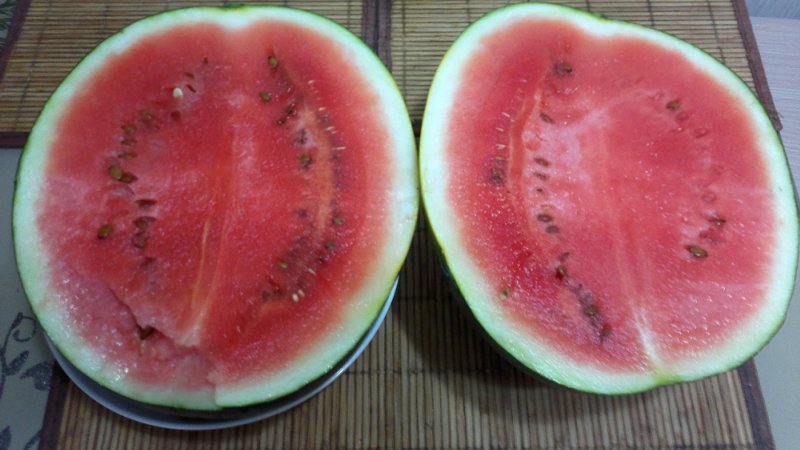
After the purchase, it is worth checking the pulp of the watermelon itself. By color, consistency and texture, you can also determine whether it is safe for consumption:
- If the pulp is unevenly colored and has wide white or yellow streaks this means that the watermelon was pumped with fertilizers and harvested before it was ripe.
- Bright red with a purple tinge flesh also testifies to the abundance of nitrates and additives that artificially give it a "ripe" color.
- Perfectly smooth ("mirror") pulp on the cut - a sure sign of nitrate. Its texture should be grainy and without traces of mucus.
- Cavities and cracks in the pulp indicate that the growth and maturation of the watermelon was accelerated by the use of excess fertilizer.
- Sunflower seeds should be large and brown. Small and pale seeds are a sign of a nitrate fruit.
- The cavities in which the seeds lie should not differ in color. If they have a yellow or orange tint, such watermelon should not be eaten.
Other harmful substances in watermelon
Even if the concentration of nitrates does not exceed the permissible dose, there is still a risk of poisoning with the acquired watermelon.
The reason for this is the harmful substances accumulating in the pulp, in addition to nitric acid salts:
- In addition to nitrates on melons, phosphorus and chlorine can accumulate in watermelon, which are also used in fertilizers to accelerate growth.
- Unscrupulous sellers can mask the immaturity of a watermelon by introducing an E124 additive into it. It gives the pale pulp a red color.
- A large flow of cars passes along city roads and suburban highways. They all emit exhaust fumes that are easily absorbed by watermelons. Because of this, heavy metals - in particular, lead - accumulate in the pulp.
- In a watermelon that has been in the sun for a long time (especially if the integrity of the peel is broken), fermentation processes begin. Eating such berries can cause severe eating disorders.
- Violation of the integrity of the crust also leads to the ingress of various dangerous microorganisms into the pulp.
- If the watermelon is damaged even on the melon, there is a risk that mineral fertilizers and pesticides that are used against insects will get inside it. Both that, and another can lead to dangerous consequences for the body.
Usually the owners of small farms and street vendors resort to fraud.... But large stores should not be completely trusted either.
A number of inspections showed that even in large networks there are watermelons with a dangerous concentration of harmful substances. Therefore, in the slightest doubt, ask for product certificates and test results.
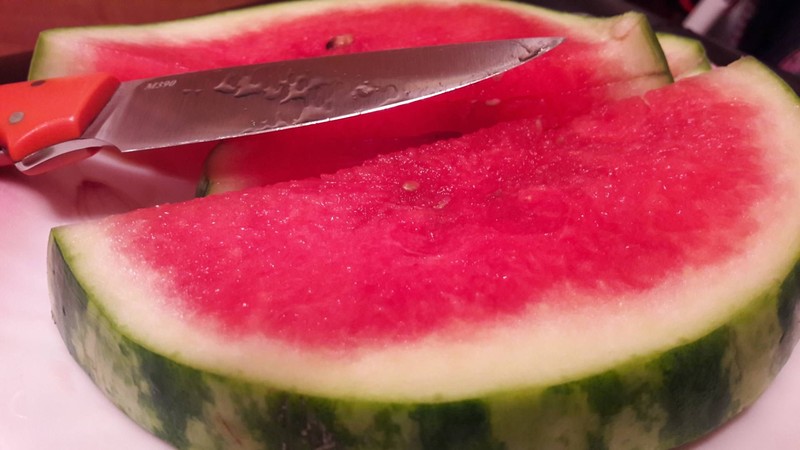
Tips & Tricks
To prevent nitrates from getting you in trouble, you need to know a few rules that will minimize the risk of harming the body:
- it is worth buying watermelons only in large stores that check the quality of incoming products;
- buying from street vendors is dangerous - there is no guarantee that the product has passed all the checks and has a certificate;
- in no case should you buy watermelons from open counters near the roads - these berries absorb harmful substances from the exhaust gases;
- unripe watermelons are especially dangerous - it is at the initial stage of ripening that the concentration of nitrates in the fruit is maximum;
- the purchased watermelon must be thoroughly washed before use - nitrates dissolve in water, and the risk of adding dirt to the pulp when cutting is reduced;
- unseasonal watermelons can contain much higher doses of nitrates than ripe watermelons. Those wishing to please themselves with these berries early need to carefully check them and be sure to clarify where the watermelons were brought from. In warm countries, they ripen earlier, but there is a risk of purchasing irrigated watermelons, which are grown with a lot of fertilizers.
Laboratory studies of watermelons have shown that the highest concentration of nitrates is observed right under the skin. Therefore, those who like to eat a sweet berry to the very crust should give up this habit. Eat only pink pulp.
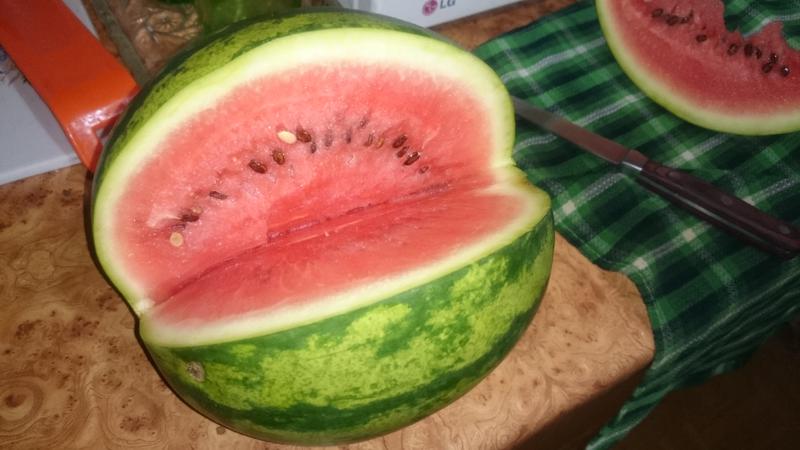
What to do in case of watermelon poisoning
If the purchased watermelon turned out to be nitrate, and the buyer ate a serious portion of the dangerous berry, nitrate poisoning may occur. This is a rare occurrence, but it is fraught with dire consequences. Its signs appear 3-5 hours after consumption:
- bouts of nausea;
- vomiting;
- diarrhea;
- low blood pressure.
Chills, blueness of the lips, rapid pulse, shortness of breath and damage to internal organs are also possible. Even convulsions and loss of consciousness are possible.
If you find these signs, you need to do the following:
- drink plenty of warm salted water;
- induce vomiting two minutes after drinking water;
- repeat these steps several times;
- take medications that help with poisoning (activated carbon or Enterosgel);
If diarrhea, weakness, and shortness of breath persist and loss of consciousness occurs, emergency treatment should be sought. Self-medication for such symptoms of nitrate poisoning can only aggravate the situation.
Important! During treatment, alcohol is categorically contraindicated. It aggravates the toxic effect of nitrates.
Conclusion
Watermelon is one of the leaders in the ability to accumulate nitrates and harmful substances. Because of this unpleasant property, carefully approach its choice in stores.
Always choose large stores where the product has the required certifications. Pay attention to the appearance of the rind and pulp, and check the watermelon for nitrates using any of the methods listed above. Compliance with these rules will allow you to feast on striped berries without health risks.